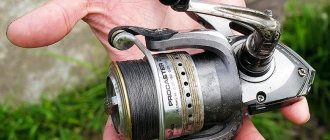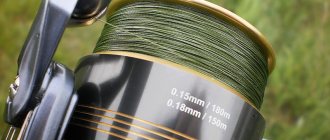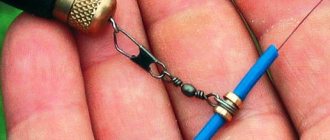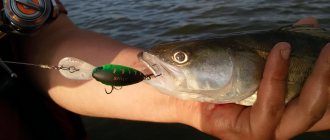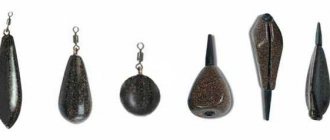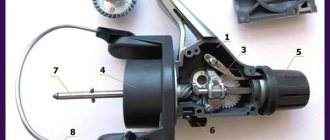Casting with a carp rod, tips for increasing range
Using the long-range universal casting technique, you can use both single nozzles and special PVA packages. When carp manifest themselves at large distances from the fisherman and regular casting does not allow delivering the bait to the right place, long-range casting will come in very handy. With practice, you will be able to cast the rig not only very far, but also quite accurately.
During such a cast, the rod will compress more than with a standard cast from behind the head, and therefore the speed of the tip and sinker increases, which in turn has a positive effect on the distance.
Such an ultra-long cast requires a rather unusual position of the performer’s body, so first it is advisable to practice only with the rod itself, without weight or equipment.
So, first you need to position your feet correctly at an acute angle (about 45°) to the direction in which you are going to cast the rig. We turn the body so that the chest is at a right angle to the casting direction. The position of the straightened left arm is slightly above the head, while the right arm is laid back and slightly bent to make it more comfortable for the fisherman, and the tip of the rod pointing down is about 1 m from the ground. The gaze should be directed a little further than the chosen target location, in order, if necessary, to stop the cast being too low. In the photo you can see the approximate position of the fisherman’s body when performing this universal casting with a carp rod.
Having learned to take the correct initial position, it is worth practicing only with a “naked” rod in order to get the correct arc. Remember that the rod in this case also moves over the shoulder, and not from the side around the body.
After practicing the technique itself, you can move on to full-fledged attempts at ultra-long casting. Having taken the required position, pay attention to the location of the sinker itself, which ideally should be on the line between the tip and the heel of the left foot. The sinker and rig will lie on the ground. This position of the equipment should not confuse you, since directly during casting it will instantly rise and will not drag along the ground.
If you want to bring this casting to perfection, sending the bait to a distance of 180-190 m, pay attention to a number of small, but quite important points.
What is the potential of universal casting?
Photo No. 6
Depending on the reservoir, competently/executed universal (long-distance) casts can provide you with real advantages! Especially on pressed lakes and ponds, where, through their use, you can deliver your baits and bait - precisely to those areas that are under the most minimal pressure, which will certainly bring good results!
It is also worth noting that during training, these casts look like an amazing sight! Personally, my records for this kind of casts (sinkers) exceed the 250-yard mark. As for other carp anglers, many of them today are capable of casting at a distance of over 170 yards, but (!) with equipment and bait!!!
So, we conclude the article in which I provided you with, in fact, step-by-step instructions for performing an ultra/long cast, just like in the previous material, where I described casting overhead. Never forget that the rod is moving over your shoulder, and not somewhere to the side (this is the most common mistake when performing universal casts). Once again, take a close look at photographs No. 3, No. 4, No. 5 and No. 6 (where the starting position is shown at the back). After studying the photo, it will be easier for you to understand in what position your body, arms and weights should be. Your very first cast should be done slowly. Wish you luck! I’ll be back to you again soon, but with new “tricks” for extreme/long-distance fishing for large carp!
Author of the article: Terry Edmonds / Terry Edmonds Translation source: www.mainline-baits.com
Publication author
offline for 10 months
Long casting with a carp rod (tips)
- The smaller the nozzle, the less air resistance will be. For this reason, it is better to use small (1-1.5 cm) nozzles.
- When the rod feels too stiff during an ultra-long cast, you should increase the line hang, and vice versa, reduce it when the rod feels too soft.
- The sinker must be aerodynamic and weigh at least 3 ounces.
- Use short leaders that keep the bait close to the sinker during flight.
- To reduce friction, the line is wound onto the spool almost to the very edges.
- Lower guide rings with a diameter of 50 mm also reduce line friction well and increase casting distance.
- Thin monofilament line or braided cord flies further. However, remember that during casting there is still a chance of getting caught on grass or a branch.
For crucian carp with long casting - Fishing - Okhotniki.ru
In summer, crucian carp often go out to feed in shallow waters far from the shore, where it is impossible to cast with an ordinary fishing rod. At the same time, he often chooses areas adjacent to aquatic vegetation, therefore, to avoid snagging on the grass, the cast must be targeted. In hot, windy weather, crucian carp can feed at mid-water in open spaces free of algae.
And here's what you need to know: Fishing hooks - how to choose and how to tie
You can catch crucian carp with match tackle both from the shore and from a boat. In the second option, the boat allows you to get closer to areas that are impossible to approach along the coast due to its features.
TACKLE
The length of a match rod designed for catching crucian carp in ponds can vary between 3-5 m. They usually consist of two or three legs with a large number of guide rings that do not affect the structure of the rod.
The rod is also equipped with a comfortable cork handle with a reel seat, and you need to select the appropriate spinning reel for it. The latter should have a small spool diameter, with a gear ratio of approximately 5.5:1-6.5:1.
The casting distance depends on the total weight of the equipment. Equipment with a test of 10-15 g provides a short or medium casting range, with a test of 20-25 g - an average distance, and for casting 30 meters or more, a load of 25-35 g will be required.
FLOAT
An unloaded float in this case works worse. In strong winds, the weight of the float must be increased.
Waglers can differ significantly from each other. First of all, this concerns their loading - it can be constant or variable.
The loading is changed by adding or removing one or more washers, which load the float at the base.
More often than others, wagglers with an elongated body in the form of an elongated olive are used for various fishing conditions. At the bottom of the body there is most often a support; in addition, an antenna made of a plastic tube or peacock feather is built into the body.
To see the fish bite when fishing at a long distance, the antenna must be painted in a clearly visible color. When using a sliding float rig, which is used in match fishing even for fishing in shallow waters, locking units can be used.
They serve to fix the descent of the float with sliding and some types of blind equipment. They are tightened so that they can be moved without deforming the line.
And here's what you need to know: Repairing a broken spinning rod and rod knee
When choosing a fishing line, you need to take into account not only the size of the expected fish, but also the fishing conditions: wind, depth. Typically, when long-range fishing, fishing lines no thicker than 0.2 mm are rarely used.
It is better to equip your fishing rod with special fishing lines designed for match fishing. They are usually quite soft, sinking or conditionally sinking, which is why they are less blown out in the wind.
Match fishing lines rub less and get tangled, and do not form rings. For match fishing, it is more convenient to use fishing lines colored by sectors.
Or, when fixing the casting distance, use a waterproof marker, which is used to mark the fishing line after casting to the baited point.
Carp reels for long casting
The casting distance is also greatly influenced by the reel. The reel should be large, roomy and have a smooth spool surface. The maximum casting range is achieved in reels that have a cone-shaped elongated shape (Long cast). The quality of the line laying machine is no less important.
Carp rod
An example of a good carp spinning rod is the Brillant Carp 2011 model from the German company Sportex. Its test is 3.5 lbs, equipped with a Mitchell Avorunner reel (long-cast spool with a straight taper), line diameter - 0.24 mm, a sinker weighing 125 g and a Climax Duramax shock leader 0.35 mm.
Externally, this rod does not look like a representative of the “long-range” category, but already in your hands you can clearly feel its power and slenderness. The model is easy to use (in particular when fishing), and long-distance casting is quite easy.
Swish sinkers
Of course, a novice fisherman has many mistakes and inaccuracies in technique. However, the first thing I want to draw your attention to is a simple but important thing - sinker hang. By this I mean the distance from the rod tip to the sinker before casting.
As a rule, it should be 1.5-1.8 m. Since we are using a 3 meter long rod, the optimal length would be 1.4 meters. In order not to measure the distance with a ruler every time, it is best to install the sinker at the level of the joint of the rod’s knees.
This is an extremely important aspect in order to load the entire rod evenly and generate more power. Many novice anglers often wind the sinker close to the tip, so only the tip of the rod is involved during casting.
The optimal length of the sinker overhang is usually equal to the joint of the rod knees.
After this, the girl makes a few more casts with the sinker hanging correctly, so far without any other changes. It is always important for a quitter to feel the difference from one change and “accept” it.
How to choose a rod for ultra-long casting
As I warned earlier, below I use some excerpts from my article entitled “Chasing Perfection”, where I gave a detailed overview of making a carp rod specifically for extreme long casting. Working closely with Steve Harrison (owner of the family business Harrison Advanced rods) and Vic Gibbson (a great master at creating the world's finest custom rods). I hope that after reading these excerpts, you will understand what you need to pay special attention to when choosing a rod for casting over long distances.
I don’t believe that anyone (or ever) will be able to create a “universal” rod that is equally effective under any circumstances (which can be encountered during the “hunt” for carp). I believe that for almost any (specific) conditions it is necessary to use strictly (!) separate rods. Agree, you won’t use a kitchen knife, albeit a large one, for chopping wood or, conversely, an ax for cutting bread? It is possible that you are a mega-talented person and can do this, but it is much better: use an ax to chop wood, and use a knife to cut bread. Is not it?
For several years, for ultra-long distance casting I have been using a fairly powerful 13-foot Armalite “Top Gun” carp rod (test: 3.5 feet). Custom made by Vic Gibbson, specially with five SiC rings and a special mount, “tailored” to the Japanese Fuji reel.
So, it worked just perfectly, and could easily throw even 4-ounce sinkers, while absolutely not interfering when fishing for carp. But it had an impressive weight and an overly rigid tip, which often served as the main reason for the hook being pulled out, especially at very long distances.
A carp rod for long casting is a purely individual (very personal) thing! Just for fun, ask seasoned carp anglers about any of their fishing rods, I guarantee you will get completely different answers.
At one point, I decided to form my own opinion about the ideal fishing rod for me personally. Not paying attention to the “tempting” advertisements praising certain super models with “amazing casting characteristics” on the pages of carp fishing magazines. Of course, I believe them, but... I’d better check everything! That was my decision.
So, having tried many blanks, in fact all the TOP fishing rods in the world (recommended by leading carp anglers), I found what I had been looking for for so long. This is a Liverpool model rod from Harrison Advanced Rods, 4lb test, 12.5ft long. It was with him that I felt completely confident!
I described in detail to the local representative of the company what characteristics I needed, and in general everything that I expected from my future purchase. Since I wanted to increase the dough to 4 pounds and change the color of the form, he had to contact the main office. And, surprisingly, Dr. Harrison himself personally agreed to fix everything “for me.” As a result, we agreed on the following rod parameters:
- The total length of the form is 12.5 feet, consisting of 2 sections, with an advanced type of “overfit” connection;
- Test (strictly according to my quirk) - 4 pounds;
- The action is for successful casting of heavy weights (weighing 4-5 ounces) over long distances. At the same time, it must be fast, well-balanced, and capable of fighting carp, even at close range.
- The color is virtually any, except gray and black.
Now, I’ll explain my choice a little. Since I am not very tall, for comfortable fishing I prefer to use “short” rods (13-foot modification). As for the color, I have long dreamed of holding in my hands such forms that would differ from the standard (and quite boring to me) colors that are colorful “here and there” in many reservoirs of the world.
Custom-made for me, the rod was equipped with (highly durable but very light) titanium Sic guides and a special mount for my favorite Fuji reel.
I finally had fun, I could throw heavy weights with this rod without fear. And, most importantly, it cannot be called a “hoe” (like the previous model), since it simply played the tip perfectly when playing, even with large fish, right under the shore.
But it was a custom order (almost handmade). Therefore, I bring to your attention several “store-bought” carp rods that have successfully passed my tests:
- "Jim Gibbinson Eclipse" (x-ki: 13 ft; 3.25 TC) from ;
- “Insight” (x-ki: 13ft; 3.5TC) from ;
- "Rod Hutchinson IMX" or "Dream Maker" (x-ki: 13ft; 3.5TC SU) from the brand "Rod Hutchinson";
- "Orient Power Plus" (x-ki: 3.5 to 5TC) brand "Leon Hoogendijk".
I assure you that all these rods, with your hands (growing from that place), using a well-chosen reel, the right fishing line and other normal equipment, are capable of casting sinkers over mega steep distances.
Make a reasonable/optimal choice, but remember that for special types of work, stores sell special tools that may never (!) be useful at your nearby pond.
Correct grip
The next step on the path to success is a secure grip on the rod. Beginners, including our girl, often hold the rod in place of the reel foot between the middle and ring fingers. At first glance, placing your fingers “in the center” may seem logical, but a more secure grip for a carp rod is to place the reel leg between your ring finger and little finger.
Katya again makes a series of casts and already feels that this arrangement of fingers is much more convenient. In addition, when the index finger releasing the line is higher, it is easier to catch the moment the line is released.
Mark changes his grip on the rod and reel.
1. Beginners often hold the rod by the reel leg between the middle and ring fingers.
2. It is safer to position your fingers so that the coil leg is located between the ring finger and little finger.
Hand placement
As with the near-rod grip, many beginning anglers hold the rod closer to the center with their front hand rather than near the edge. When you take a carp rod in your hands for the first time, it is more comfortable to place your hands close to each other in order to better control it. But this is a deceptive feeling, taking away several meters and accuracy.
Your front hand should be as close to the base of the rod as possible. Thus, when making a cast, the thrower will push it towards himself, putting a load on the entire form.
The front hand should grip the base of the rod to fully load the blank when casting, as in the second image.
The girl makes several casts and you can already see how her range has increased by several meters, and the sinker began to fall in one area of the water area, which indicates an increase in accuracy.
Long casting line
The diameter of the fishing line used in a carp spinning rod should be 0.24-0.28, since a fishing line that is too thick will increase resistance when casting. In order to minimize the level of line resistance, professionals use a special lubricant. If you don’t have one in your inventory, you can simply wet the spool and rings of the spinning rod in water, which will also reduce friction.
Installing the spool
A quick tip that should become a habit. Ideally, the reel spool should be at its highest point. On some reels, the spool rises several centimeters, lengthening, and this should have a positive effect on the accuracy and casting distance.
Katya adds this aspect to her technique and makes several casts. The learning process proceeds gradually and each new element is practiced.
It is advisable to have the spool in the top position before casting.
Aim high and...push
A major problem many beginners have is that they don't use their front hand and only push the rod with their back hand. The beginning of the movement of the rod should just be provoked by the movement of the front hand towards you towards the chest. This needs to be worked out in your head.
It took Kate 20 minutes to stop pushing the rod with her back hand and actually use her front hand. The brain thinks that since I need to move forward, I will push the rod forward. But in fact, the front hand should push towards itself as hard as possible, and only then the back one turns on.
This is the first element of casting technique that a novice angler needs to remember. Then you can add the following. You can't try to explain everything at once. Training should be gradual so that a person can calmly assimilate all the information and then apply it.
I also gave her the optimal trajectory. It is necessary to release the line at a moment when the sinker can fly at an angle of 45 degrees. To do this, it is advisable to look at the sky from this angle.
The front hand should push the rod toward your chest. The stronger the push, the further the sinker will fly.
How to make a long cast
When casting long distances for carp, it is not necessary to cast the tackle as far as possible beyond invisible horizons.
Fish sometimes just walk around our feet, and we don’t notice it.
But still, any self-respecting carp angler should be able to make long-distance casting to carp. Carp walking in the distance must get bait under their curious nose.
LONG CAST EQUIPMENT
Long casting rod
The most convenient rod at present is the one with a length of 3.6 meters and a weight of 1 and 1.5 kg. test, or 2-3 lb. The rod should be equipped with a tip with excellent and fast recovery speed.
How to make a long cast with a medium action rod
If the rod has a medium action, then a long cast can be performed by observing a certain point: the force applied during a long cast should be applied more slowly, with a slight delay.
The rod guides, their number and the distance between them, play an important role in the long-distance casting technique. Many rings mean vibration and distance reduction. Few rings are loops of fishing line that stick to the rod and reduce the casting distance.
The size of the guides also plays a role in long casting. Your rod must be equipped with rings with a diameter of at least 40 millimeters.
Long casting rod reel
- Carp reels are mostly large in size. Thanks to this size, these reels can cast long distances without any problems. But if you want the longest cast, use reels like the BIG PIT. These reels have an ideal spool diameter and weight.
Rod line for long casting
- The main line for long casting must be very strong. Because we catch big fish, as well as the presence of algae, snags and other fishing conditions. Choosing braid or monofilament is up to you. There is no difference, the main thing is that the fishing line must be strong.
Line lubricant
- Sometimes it makes sense to use line lubricant. This helps for long casting to carp. Lubricating the line reduces vibration, allowing you to cast further. The lubricant needs to be renewed after a few hours. A line that has been in water for three to four hours must be lubricated again because the lubricant is washed off.
Shock Leader
- The Shock Leader is a very important part of your long casting rig. Shock Leader increases the reliability of your equipment and the line will withstand the force that you put into long casting and will not break.
There are certain conditions for using a shock leader. If you use a sinker weighing 85-90 grams, then a shock leader of 10-13 kilograms is used. Here in this proportion.
Sinker - its size, sinker fastening and type
- The size of the sinker is also a very important point when casting long distances. A very small sinker will not allow you to make a long cast, because it will not create the proper tension in the rod. A very large sinker can break your rod, overloading it and causing you to lose long-casting power.
The style of the sinker also plays an important role. A blunt, short sinker is good as a self-hooking hook. But such a sinker has poorer aerodynamic properties than more elongated ones.
Modern sinkers are either sliding or clip-on. The method of attaching the sinkers is also considered an important factor. The best option for attaching a sinker for long-distance casting is the “helicopter” mount.
HOW TO MAKE A LONG CAST
Give a bad fisherman a great long casting rod and he still won't be able to cast properly. Do you understand what I'm talking about?
Mechanics of long casting
With the help of a sinker you create inertia. Start moving your rod forward, it will bend back. Once it reaches a certain point, the tip of your rod moves forward, creating a whip-like motion. It doesn't matter how stiff your rod is, they all don't have the ideal casting action. They may break under extreme stress.
When moving the rod forward, your speed and force should be controlled and slow.
Body weight transfer
Now let's move on to another extremely important aspect of the technique, which can bring the most meters. I am a former professional golfer, so I understand the importance of transferring body weight. Every carp angler should realize this.
Let's start with the rack. The legs should not be too wide apart or too close together. The fisherman must stand confidently and not dangle from side to side. The front foot points in the direction of casting, the back foot to the side.
Since the girl is not very tall, her legs are located 35-40 cm from each other on the same line. The main weight before casting should be concentrated on the back leg. The leg can be slightly bent at the knee for comfort and shock absorption.
As you cast, take a slow, deep step with your front foot and shift your weight from your back foot to your front foot. At the same time, as we have already discussed, the front hand pushes the rod towards you, and the back hand pushes forward.
A deep step allows you to transfer weight from the back foot to the front foot and load the rod, which then “shoots”.
On the first try, the girl correctly distributes her weight and the sinker flies into the distance with a whistle. A few more throws and the beginner is no longer completely new to casting techniques. In just a couple of hours, Katya mastered the correct technique, remembered important nuances and practiced well.
What gear to use
You should prepare skillfully, taking into account fishing conditions, type of reservoir, and weight of fish. Each part must meet certain carp fishing requirements. The installations themselves are selected depending on the time of year, the reservoir, its bottom and sometimes a number of other factors.
We advise beginners to start with something simple, this will give them the opportunity to get acquainted with this complex area, gain some insight and understand what is most convenient for you. Listed below are the most common approaches, with observations and very important tips.
Hooks and their forms
The hook is necessary for self-hooking fish. If it is chosen incorrectly, then you will not catch big fish. Hooks with a straight tip are more often used. It catches well with the sting looking inward. You need a barb on the hook, especially when fishing.
In reservoirs with dense vegetation, hooks with a long shank are used. In clear water it is better to fish with a short one. A wide bend is important so that the area of the fish's mouth to grip the hook is sufficient.
Sinker
The main factors in choosing cargo will be:
- strong retention of equipment at the feeding point;
- timely notification of a bite thanks to the tension of the fishing line;
- ensuring the location of the bait at the required distance.
Round sinkers are a good option for medium-distance fishing on hard-bottomed waters. Pear-shaped ones are stable in silted areas, and in the shape of a flat arrow - in places where there is a lot of vegetation and reeds.
Leashes and their length
Tie leashes of different lengths:
- For fishing on lakes with a hard bottom, an average of 20 to 30 centimeters is suitable.
- On muddy bottoms, up to half a meter long are needed.
- Short ones of 10-20 centimeters will be needed during the current.
With long leashes, the tackle cannot be cast far. It is believed that short leashes are more effective on carp, since the fish’s body is elongated.
Anti-twist: important points
In tandem with the safety clip is an anti-twist device. Part of the equipment is needed to avoid overlaps when landing fish. An anti-twist is made from silicone tubes
And here it is important to pay attention to the smell coming from the material. Pipes should not be repulsive due to their aroma and shiny surface
What size swivels should I use?
A swivel is used at the point where the sinker connects. It prevents overlaps and twists. The question often arises regarding sizes. For carp, you need universal swivels number 10. For a large trophy, a tungsten model is desirable.
Further work
With each cast, I try to correct the nuances of the stance and the trajectory of movements. The girl tries to remember everything and put it into practice. In a couple of hours of training, she has come a long way for a beginner and is already boldly sending the sinker a decent distance.
She already notices her mistakes and corrects them. This is what I call real casting technique training. I should note that from the very beginning, our ward correctly straightens her arms above herself before making a throw and does not pull them back. Many even experienced carp anglers often instinctively try to swing before throwing, so they move their hands back behind their heads. There is no need to do this!
Already before casting, Katya herself evaluates her mistakes.
It already looks like a power throw.
The real training is if by the end of the day you no longer have enough strength to reel out the fishing line.
Now it's time to compare the results. Katya makes several power throws, some of which fly along an ideal trajectory, so I am confident of a pleasant outcome. Two throws approaching the 115 meter mark! Even considering the fact that she was casting without a rig with a bare sinker, it was very impressive. In a couple of hours, progress of 50 meters cannot but rejoice.
